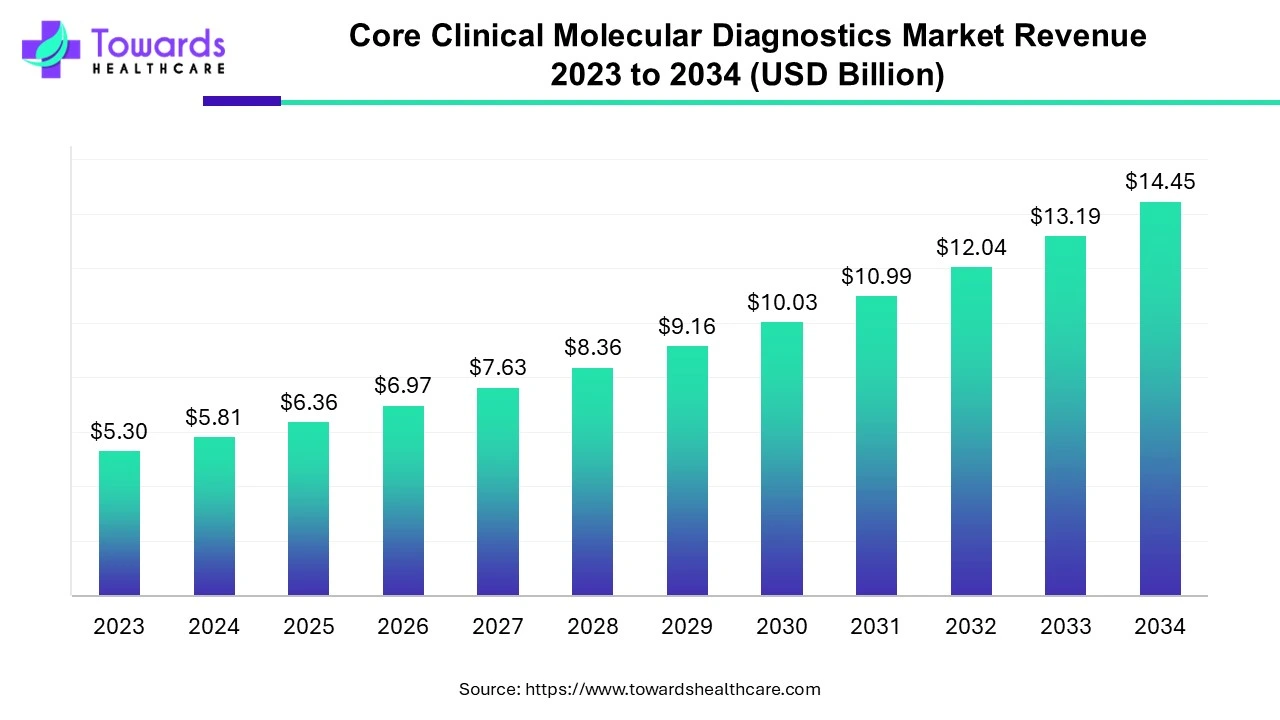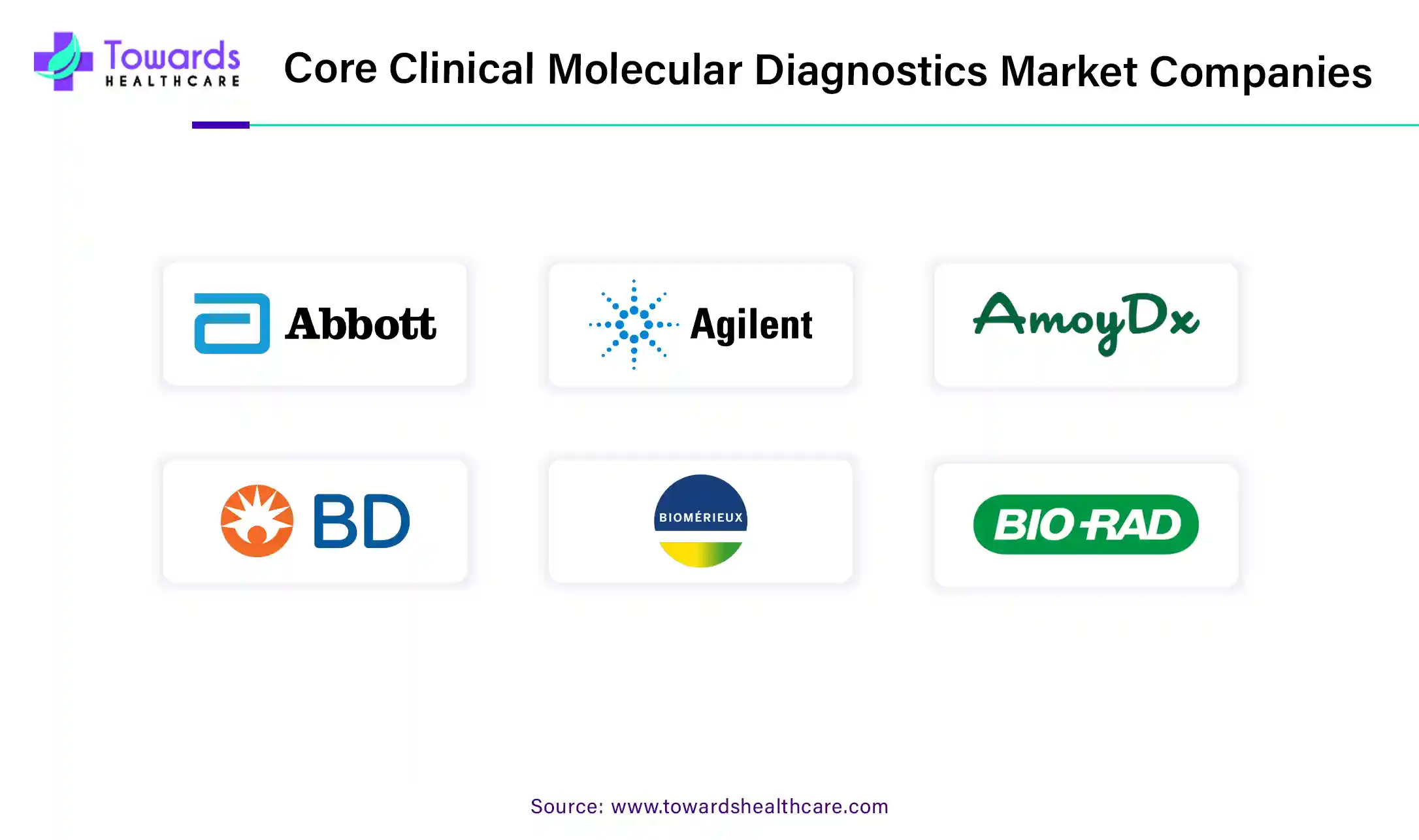April 2025

The core clinical molecular diagnostics market was estimated at US$ 5.3 billion in 2023 and is projected to grow to US$ 14.45 billion by 2034, rising at a compound annual growth rate (CAGR) of 9.54% from 2024 to 2034. The rising prevalence of chronic disorders like genetic and infectious disorders, increasing molecular biology research, and technological advancements drive the market.

Core clinical molecular diagnostics is the application of molecular biology techniques to study human diseases, including infectious diseases, inherited conditions, and cancer. It is a type of molecular diagnostics that mainly focuses on patient care using diagnostic techniques. Molecular diagnostics is based on genomic and proteomic analysis techniques. The common methods used in molecular diagnostics include nucleic acid isolation and quantification, PCR amplification, sequencing, and STR analysis. Core clinical molecular diagnostics techniques identify biological markers in humans by applying molecular biology to medical testing.
The rising geriatric population leads to the increasing prevalence of chronic disorders. Chronic disorders such as somatic and inherited genetic disorders, cancer, and infectious diseases potentiate the demand for analyzing biomarkers for the effective treatment of disease. The growing research and development activities such as genomics, proteomics, and molecular biology boost the market. The rising demand for point-of-care diagnostics and personalized medicines augment the market.
Artificial intelligence is revolutionizing the world, especially the future of molecular diagnostics. AI can enable faster and more accurate analysis and comprehension of enormous volumes of medical data. As these technologies provide fast and more accurate diagnostics, they lead to the development of tailored treatment strategies based on individual patient needs. Machine learning (ML) and AI can also enable the prediction of protein structure. AI can significantly reduce the complexity of various molecular diagnostic techniques, providing faster results with lower costs and a lower risk of errors. Additionally, AI can store and analyze large amounts of patient data to generate hypotheses and suggest potential diagnoses. Pattern recognition software can pre-process data and analyze digital medical images. ML techniques are used to identify patterns and anomalies in electronic health records.
The major challenge of the market is the limited accessibility of molecular diagnostic techniques in certain low-income regions, restricting their adoption. The major factors leading to less adoption are the high cost of the equipment and the high overall research cost. Additionally, suitable infrastructure is required to carry out research activities and stay competitive in the market with technological advancements. These requirements are limited in LMICs.
North America held a dominant presence in the core clinical molecular diagnostics market in 2023. The presence of key players, state-of-the-art research and development facilities, technological advancements, and favorable government policies drive the market. In November 2022, the FedDev Ontario Minister announced an investment of $2 million for SQI Diagnostics, a leading diagnostics company, to discover and develop rapid diagnostic testing for the North American clinical and patient market. It is estimated that more than 30 million people are reported to have rare diseases in the US. While in Canada, it is estimated that one out of every twelve people has a rare disease. In 2023, 613,331 people died due to cancer in Canada, necessitating early detection and screening of cancer.
Asia-Pacific is estimated to grow fastest in the core clinical molecular diagnostics market during the forecast period. The rising geriatric population, increasing prevalence of chronic disorders, and increasing investments & collaborations drive the market. The rising demand for point-of-care (POC) diagnostics and in vitro diagnostics (IVD) for detecting and screening chronic disorders boosts the market. Several government organizations in China, India, and Japan have initiated various programs to enhance their availability and accessibility across the region. The Chinese government is investing heavily in building up the country’s in vitro diagnostics (IVD) testing capacity and meeting the strong clinical demand of an aging population.
By product type, the reagents segment dominated the core clinical molecular diagnostics market globally in 2023. Reagents are the pre-dominant requirements of assay kits. The kits can be reused after obtaining new reagents. Commonly used reagents for molecular diagnostic techniques include enzymes, buffer systems, etc.
The instruments segment is expected to grow at the fastest rate in the market during the forecast period. The different types of equipment used in molecular diagnostics include DNA sequencers, incubators, qPCR machines, automated nucleic acid extractors, etc. The demand for these instruments increases due to technological advancements.
By technique, the PCR segment registered its dominance over the global core clinical molecular diagnostics market in 2023. Polymerase chain reaction (PCR) is the most common molecular diagnostic test. PCR technique is used to identify DNA sequences. The rising prevalence of genetic and infectious disorders and technological advancements demand the use of PCR. The COVID-19 pandemic also increased the demand for PCR and RT-PCR techniques for diagnosing the presence of the virus.
The nucleic acid sequencing segment is anticipated to grow with the highest CAGR in the market during the studied years. Nucleic acid sequencing is the process of determining the order of nucleotides in DNA. The growing research and development in molecular biology, metagenomics, forensic investigation, and disease diagnosis boosts the segment’s growth.
By application, the infectious diseases segment led the global core clinical molecular diagnostics market in 2023. The rising prevalence of infectious diseases such as COVID-19, influenza, HIV/AIDs, etc., promotes the demand for molecular diagnostics for their detection. The molecular diagnostic techniques used for the detection of infectious diseases include PCR, isothermal amplification, gene chips, and high-throughput sequencing.
The cancer screening segment is projected to expand rapidly in the market in the coming years. The increasing incidences of cancer drive the use of molecular diagnostic techniques for its early detection. The complexity of the disease, increasing investments, and favorable government policies augment the segment’s growth.

Dinesh Chauhan, CEO of CORE Diagnostics, highlighted the economic benefits of high-end diagnostics in an interview in June 2023. He stated that high-end diagnostic testing provides a more accurate and personalized approach to healthcare, resulting in improved patient outcomes and economic benefits for the healthcare system. The increased investments and public-private partnerships drive the opportunity to implement these technologies. He concluded that investing in high-end diagnostics can create a more efficient, effective, and sustainable healthcare system for all.
By Product Type
By Technique
By Application
By Region
April 2025
April 2025
April 2025
March 2025